Click here to learn more about the How to Identify article series.
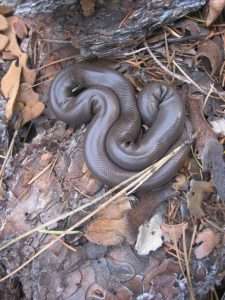 Name: Northern Rubber Boa (Charina bottae)
Name: Northern Rubber Boa (Charina bottae)
Range and typical habitat(s): Western North America from southern British Columbia to central California, though possible populations may exist in southern California. From the coast eastward to portions of Montana, Wyoming, and occasionally Colorado.
Distinguishing physical characteristics (size, colors, overall shapes, detail shapes) and behaviors: There’s really nothing that looks like a northern rubber boa (except the southern rubber boa, which we’ll discuss later.) A nearly perfectly cylindrical chunk of a snake, with a bluntly tapered head that merges smoothly into the neck, it often looks almost like a toy snake to someone who’s never seen one before. The end of the tail is characteristically blunt.
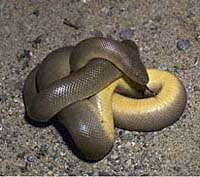 Its loose, smooth-scaled skin gives it the appearance of being made of rubber. The dorsal side is often uniformly light brown through olive, while the ventral side is generally paler. The eyes are the same brown as the scales, making them appear to blend in with the rest of the snake. Young individuals may be pinkish in color, but darken with age. The largest rubber boas may reach nearly three feet in length; females are larger than males.
Its loose, smooth-scaled skin gives it the appearance of being made of rubber. The dorsal side is often uniformly light brown through olive, while the ventral side is generally paler. The eyes are the same brown as the scales, making them appear to blend in with the rest of the snake. Young individuals may be pinkish in color, but darken with age. The largest rubber boas may reach nearly three feet in length; females are larger than males.
Northern rubber boas are rarely seen during the day, being primarily nocturnal and well-camouflaged. They are found in a variety of settings, from forests to meadows to chaparral, at elevations from sea level to alpine regions over 10,000 high. They often spend the daytime hiding underground or under leaf litter and other sheltered places, and then come out at night to hunt.
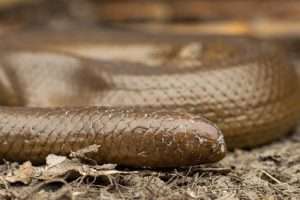
Rubber boas subsist primarily on rodents like mice and voles, though they may have a varied diet including eggs, amphibians, birds, and other reptiles. They are remarkably docile and usually defend themselves through musking rather than biting. A threatened rubber boa may wrap its body around its head and expose its tail to make the predator think that is the head, hence the blunted shape. The tail may also be damaged by the parents of young rodents as the snake attacks them in their nest.
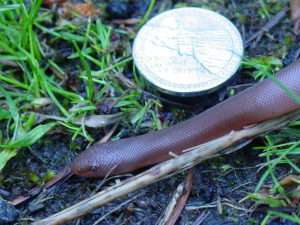
Rubber boas give birth to live young after mating in spring, after emerging from winter brumation. The female may have up to nine babies, though smaller clutches are more common. They do not reproduce every year; a female rubber boa may only give birth every four years or so, generally in late summer or the first half of fall.
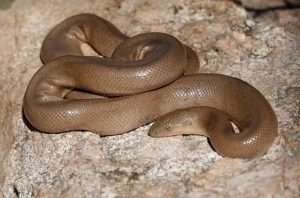
Other organisms it could be confused with and how to tell the difference: The only snake anywhere in the northern rubber boa’s range that looks anything like it is the southern rubber boa (Charina umbratica). The two species look virtually identical, and have previously been considered by some to be subspecies rather than distinct species, though more recent genetic research supports their separation.
One of the main ways to distinguish between these two very similar two species is location. Southern rubber boas are only found in the San Jacinto and San Bernardino mountains, usually between 4,000 and 7,000 feet in elevation. While some reports say both species may be found in areas of northern California, with hybrids in existence, others restrict C. umbratica to Southern California.
Anything else worth mentioning?
Due to their secretive nature, both rubber boa species are difficult to study, and it can be challenging to estimate a population’s numbers. The IUCN considers C. umbratica to be vulnerable due to its limited distribution and continued loss of habitat. C. bottae faces similar threats from habitat loss, though it is more widely distributed. Wild individuals should NOT be caught and taken into captivity; anyone wanting a pet rubber boa should only buy one that is verified to have been bred in captivity.
Further Reading:
WDFW: Northern Rubber Boa (Charina bottae)
Montana Field Guide: Northern Rubber Boa
California Herps: Northern Rubber Boa

What a great, informative article! I had never heard of either Rubber Boa, although I haven’t spent much time in its native region so maybe that’s to be expected. Love snakes!
This sentence may have a typo in it: “ The dorsal side is often uniformly light brown, though olive, while the ventral side is generally paler.”
“”light brown through olive,” perhaps?
Oops! Thanks for catching the typo! (Pobody’s nerfect.)
And yes, these are one of my favorite snakes, in part because getting to see one is incredibly special. I hope you get the opportunity some day!